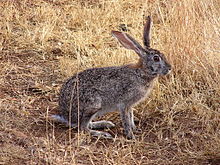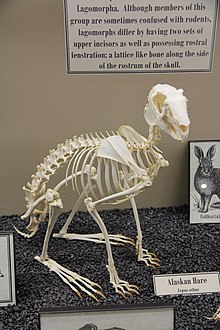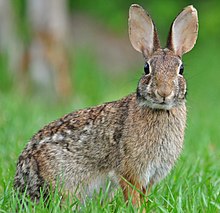|
Lagomorpha
 The lagomorphs (/ˈlæɡəmɔːrf/) are the members of the taxonomic order Lagomorpha, of which there are two living families: the Leporidae (rabbits and hares) and the Ochotonidae (pikas). There are 110 recent species of lagomorph, of which only 109 species in twelve genera are extant, including ten genera of rabbits (42 species); one genus of hare (33 species) and one genus of pika (34 species). The name of the order is derived from the Ancient Greek lagos (λαγώς, "hare") + morphē (μορφή, "form"). Taxonomy and evolutionary historyOther names used for this order, now considered synonymous, include: Duplicidentata (Illiger, 1811); Leporida (Averianov, 1999); Neolagomorpha (Averianov, 1999); Ochotonida (Averianov, 1999); and Palarodentia (Haeckel, 1895; Lilian, 2016).[1] The evolutionary history of the lagomorphs is still not well understood. In the late 20th century, it was generally agreed that Eurymylus, which lived in eastern Asia and dates back to the late Paleocene or early Eocene, was an ancestor of the lagomorphs.[3] Examination of the fossil evidence in the 21st century suggested that the lagomorphs may have instead descended from mimotonids, mammals present in Asia during the Paleogene with similar body size and dental structure to early European rabbits such as Megalagus turgidus,[4] while Eurymylus was more closely related to rodents (although not a direct ancestor).[5] The leporids first appeared in the late Eocene and rapidly spread throughout the Northern Hemisphere; they show a trend towards increasingly long hind limbs as the modern leaping gait developed. The pikas appeared somewhat later in the Oligocene of eastern Asia.[6] Lagomorphs were certainly more diverse in the past than in the present, with around 75 genera and over 230 species represented in the fossil record and many more species in a single biome. This is evidence that lagomorph lineages are declining.[7] A 2008 study suggests an Indian origin for the order, having possibly evolved in isolation when India was an island continent in the Paleocene.[8] CharacteristicsLagomorphs are similar to other mammals in that they all have hair, four limbs (i.e., they are tetrapods), and mammary glands and are endotherms. Lagomorphs possess a moderately fused postorbital process to the cranium, unlike other small mammals.[9] They differ in that they have a mixture of "basal" and "derived" physical traits. Differences between lagomorphs and other mammalsLagomorphs and rodents form the clade or grandorder Glires. Despite the evolutionary relationship between lagomorphs and rodents, the two orders have some major differences. Lagomorphs have four incisors in the upper jaw (smaller peg teeth behind larger incisors), whereas rodents only have two. They are similar to rodents in that their incisors grow continuously, thus necessitating constant chewing on fibrous food to prevent the teeth from growing too long.[10][11] In addition, all lagomorph teeth grow continuously,[12] while for most rodents, only the incisors grow continuously.[13] Lagomorph and rodent incisors are structured differently. Lagomorphs have more cheek teeth than rodents. Both have a large diastema. Lagomorphs are almost strictly herbivorous, unlike rodents, many of which will eat both meat and vegetable matter. Lagomorphs have no paw pads; instead, the bottoms of their paws are entirely covered with fur,[14][15] a trait they share with red pandas.[16] Similar to the rodents, bats, and some mammalian insectivores, they have a smooth-surfaced cerebrum.[17] Lagomorphs are unusual among terrestrial mammals in that the females are larger than males.[18] Differences between families of lagomorphsRabbits and hares move by jumping, pushing off with their strong hind legs and using their forelimbs to soften the impact on landing. Pikas lack certain skeletal modifications present in leporids, such as a highly arched skull, an upright posture of the head, strong hind limbs and pelvic girdle, and long limbs.[19] Also, pikas have a short nasal region and entirely lack a supraorbital foramen, while leporids have prominent supraorbital foramina and nasal regions.[20] Pikas Pikas, also known as conies,[21] are entirely represented by the family Ochotonidae and are small mammals native to mountainous regions of western North America and Central Asia. They are mostly about 15 cm (6 in) long and have greyish-brown, silky fur, small rounded ears, and almost no tail. Their four legs are nearly equal in length. Some species live in scree, making their homes in the crevices between broken rocks, while others construct burrows in upland areas. The rock-dwelling species are typically long-lived and solitary, having one or two small litters each year contributing to stable populations. The burrowing species, in contrast, are short-lived, gregarious and have multiple large litters during the year. These species tend to have large swings in population size. The gestation period of the pika is around one month long, and the newborns are altricial (eyes and ears closed, no fur).[22] The social behaviour of the two groups also differs: the rock dwellers aggressively maintain scent-marked territories, while the burrowers live in family groups, they interact vocally with each other and defend a mutual territory. Pikas are diurnal and are active early and late in the day during hot weather. They feed on all sorts of plant material. As they do not hibernate, they make "haypiles" of dried vegetation which they collect and carry back to their homes to store for use during winter.[19] Hares Hares, members of genus Lepus of family Leporidae, are medium size mammals native to Europe, Asia, Africa, and North America. North American jackrabbits are actually hares. Species vary in size from 40 to 70 cm (16 to 28 in) in length and have long powerful back legs, and ears up to 20 cm (8 in) in length. Although usually greyish-brown, some species turn white in the winter. They are solitary animals. Newborns are precocial (eyes and ears open, fully furred). Several litters are born during the year in a form (a nest above ground, usually under a bush). They are preyed upon by large mammalian carnivores and birds of prey.[23] RabbitsRabbits, members of the Leporidae family (excluding Lepus (hares)) are generally much smaller than hares and include the rock hares and the hispid hare. They are native to Europe, parts of Africa, Central and Southern Asia, North America and much of South America. They inhabit both grassland and arid regions. They vary in size from 20 to 50 cm (8 to 20 in) and have long, powerful hind legs, shorter forelegs and a tiny tail. The colour is some shade of brown, buff or grey and there is one black species and two striped ones. Domestic rabbits come in a wider variety of colours. Newborn rabbits are altricial (eyes and ears closed, no fur). Although most species live in burrows, the cottontails and hispid hares have forms (nests above ground, usually under a bush). Most of the burrowing species are colonial, and feed together in small groups. Rabbits play an important part in the terrestrial food chain, eating a wide range of forbs, grasses, and herbs, and being part of the staple diet of many carnivorous species. Domestic rabbits can be litter box trained, and—assuming they are given sufficient room to run and a good diet—can live long lives as house pets. DistributionLagomorphs are widespread around the world and inhabit every continent except Antarctica. However, they are not found in most of the southern cone of South America, in the West Indies, Indonesia or Madagascar, nor on many islands. Although they are not native to Australia, humans have introduced them there and they have successfully colonized many parts of the country and caused disruption to native species.[24] BiologyDigestion Easily digestible food is processed in the gastrointestinal tract and expelled as regular feces. But in order to get nutrients out of hard to digest fiber, lagomorphs ferment fiber in the cecum (in the GI tract) and then expel the contents as cecotropes, which are reingested (cecotrophy). The cecotropes are then absorbed in the small intestine to utilize the nutrients.[25] Like rodents, they are not able to vomit.[26] Birth and early lifeMany lagomorphs breed several times a year and produce large litters. This is particularly the case in species that live in underground, protective environments, such as burrows. The young of rabbits and pikas (called kits) are born after a short gestation period and the mother can become pregnant again almost immediately after giving birth. The mothers are able to leave these young safely and go off to feed, returning at intervals to feed them with their unusually rich milk. In some species, the mother only visits and feeds the litter once a day but the young grow rapidly and are usually weaned within a month. Hare young are called leverets. Adults have a strategy to prevent predators from tracking down their litter by following the adults' scent. They approach and depart from the nesting site in a series of immense bounds, sometimes moving at right angles to their previous direction.[27] Each litter of hares have a small number of young and are born after a longer gestation period.[11] Sociality and safetyMany species of lagomorphs, particularly the rabbits and the pikas, are gregarious and live in colonies, whereas hares are generally solitary species, although many hares travel and forage in groups of two, three, or four. Many rabbits and pikas rely on their burrows as places of safety when danger threatens, but hares rely on their long legs, great speed and jinking gait to escape from predators. Classification  Recent genera
Fossil genera
References
|
||||||||||||||||||||||||||||||||||


